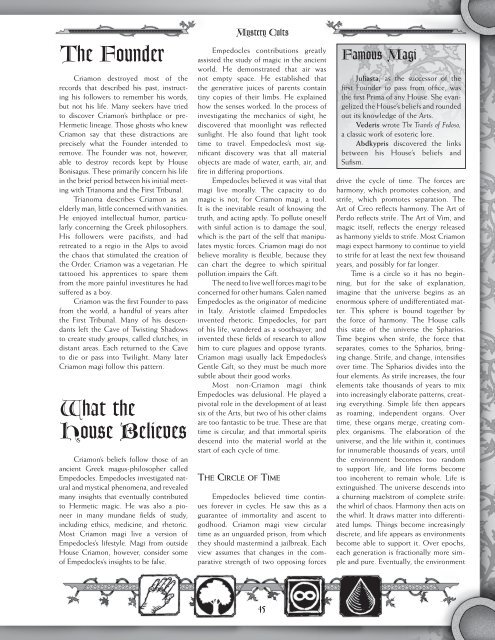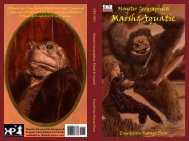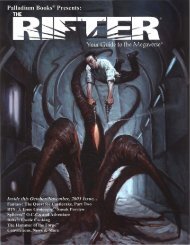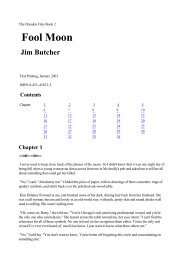Untitled - The Secrets of the Mind & Body Shaping
Untitled - The Secrets of the Mind & Body Shaping
Untitled - The Secrets of the Mind & Body Shaping
Create successful ePaper yourself
Turn your PDF publications into a flip-book with our unique Google optimized e-Paper software.
<strong>The</strong> Founder<br />
Criamon destroyed most <strong>of</strong> <strong>the</strong><br />
records that described his past, instructing<br />
his followers to remember his words,<br />
but not his life. Many seekers have tried<br />
to discover Criamon’s birthplace or pre-<br />
Hermetic lineage. Those ghosts who knew<br />
Criamon say that <strong>the</strong>se distractions are<br />
precisely what <strong>the</strong> Founder intended to<br />
remove. <strong>The</strong> Founder was not, however,<br />
able to destroy records kept by House<br />
Bonisagus. <strong>The</strong>se primarily concern his life<br />
in <strong>the</strong> brief period between his initial meeting<br />
with Trianoma and <strong>the</strong> First Tribunal.<br />
Trianoma describes Criamon as an<br />
elderly man, little concerned with vanities.<br />
He enjoyed intellectual humor, particularly<br />
concerning <strong>the</strong> Greek philosophers.<br />
His followers were pacifi sts, and had<br />
retreated to a regio in <strong>the</strong> Alps to avoid<br />
<strong>the</strong> chaos that stimulated <strong>the</strong> creation <strong>of</strong><br />
<strong>the</strong> Order. Criamon was a vegetarian. He<br />
tattooed his apprentices to spare <strong>the</strong>m<br />
from <strong>the</strong> more painful investitures he had<br />
suffered as a boy.<br />
Criamon was <strong>the</strong> fi rst Founder to pass<br />
from <strong>the</strong> world, a handful <strong>of</strong> years after<br />
<strong>the</strong> First Tribunal. Many <strong>of</strong> his descendants<br />
left <strong>the</strong> Cave <strong>of</strong> Twisting Shadows<br />
to create study groups, called clutches, in<br />
distant areas. Each returned to <strong>the</strong> Cave<br />
to die or pass into Twilight. Many later<br />
Criamon magi follow this pattern.<br />
What <strong>the</strong><br />
House Believes<br />
Criamon’s beliefs follow those <strong>of</strong> an<br />
ancient Greek magus-philosopher called<br />
Empedocles. Empedocles investigated natural<br />
and mystical phenomena, and revealed<br />
many insights that eventually contributed<br />
to Hermetic magic. He was also a pioneer<br />
in many mundane fi elds <strong>of</strong> study,<br />
including ethics, medicine, and rhetoric.<br />
Most Criamon magi live a version <strong>of</strong><br />
Empedocles’s lifestyle. Magi from outside<br />
House Criamon, however, consider some<br />
<strong>of</strong> Empedocles’s insights to be false.<br />
Mystery Cults<br />
Empedocles contributions greatly<br />
assisted <strong>the</strong> study <strong>of</strong> magic in <strong>the</strong> ancient<br />
world. He demonstrated that air was<br />
not empty space. He established that<br />
<strong>the</strong> generative juices <strong>of</strong> parents contain<br />
tiny copies <strong>of</strong> <strong>the</strong>ir limbs. He explained<br />
how <strong>the</strong> senses worked. In <strong>the</strong> process <strong>of</strong><br />
investigating <strong>the</strong> mechanics <strong>of</strong> sight, he<br />
discovered that moonlight was refl ected<br />
sunlight. He also found that light took<br />
time to travel. Empedocles’s most signifi<br />
cant discovery was that all material<br />
objects are made <strong>of</strong> water, earth, air, and<br />
fi re in differing proportions.<br />
Empedocles believed it was vital that<br />
magi live morally. <strong>The</strong> capacity to do<br />
magic is not, for Criamon magi, a tool.<br />
It is <strong>the</strong> inevitable result <strong>of</strong> knowing <strong>the</strong><br />
truth, and acting aptly. To pollute oneself<br />
with sinful action is to damage <strong>the</strong> soul,<br />
which is <strong>the</strong> part <strong>of</strong> <strong>the</strong> self that manipulates<br />
mystic forces. Criamon magi do not<br />
believe morality is fl exible, because <strong>the</strong>y<br />
can chart <strong>the</strong> degree to which spiritual<br />
pollution impairs <strong>the</strong> Gift.<br />
<strong>The</strong> need to live well forces magi to be<br />
concerned for o<strong>the</strong>r humans. Galen named<br />
Empedocles as <strong>the</strong> originator <strong>of</strong> medicine<br />
in Italy. Aristotle claimed Empedocles<br />
invented rhetoric. Empedocles, for part<br />
<strong>of</strong> his life, wandered as a soothsayer, and<br />
invented <strong>the</strong>se fi elds <strong>of</strong> research to allow<br />
him to cure plagues and oppose tyrants.<br />
Criamon magi usually lack Empedocles’s<br />
Gentle Gift, so <strong>the</strong>y must be much more<br />
subtle about <strong>the</strong>ir good works.<br />
Most non-Criamon magi think<br />
Empedocles was delusional. He played a<br />
pivotal role in <strong>the</strong> development <strong>of</strong> at least<br />
six <strong>of</strong> <strong>the</strong> Arts, but two <strong>of</strong> his o<strong>the</strong>r claims<br />
are too fantastic to be true. <strong>The</strong>se are that<br />
time is circular, and that immortal spirits<br />
descend into <strong>the</strong> material world at <strong>the</strong><br />
start <strong>of</strong> each cycle <strong>of</strong> time.<br />
tHe circle <strong>of</strong> tiMe<br />
Empedocles believed time continues<br />
forever in cycles. He saw this as a<br />
guarantee <strong>of</strong> immortality and ascent to<br />
godhood. Criamon magi view circular<br />
time as an unguarded prison, from which<br />
<strong>the</strong>y should mastermind a jailbreak. Each<br />
view assumes that changes in <strong>the</strong> comparative<br />
strength <strong>of</strong> two opposing forces<br />
45<br />
Famous Magi<br />
Juliasta, as <strong>the</strong> successor <strong>of</strong> <strong>the</strong><br />
fi rst Founder to pass from <strong>of</strong>fi ce, was<br />
<strong>the</strong> fi rst Prima <strong>of</strong> any House. She evangelized<br />
<strong>the</strong> House’s beliefs and rounded<br />
out its knowledge <strong>of</strong> <strong>the</strong> Arts.<br />
Vederis wrote <strong>The</strong> Travels <strong>of</strong> Fedoso,<br />
a classic work <strong>of</strong> esoteric lore.<br />
Abdkypris discovered <strong>the</strong> links<br />
between his House’s beliefs and<br />
Sufi sm.<br />
drive <strong>the</strong> cycle <strong>of</strong> time. <strong>The</strong> forces are<br />
harmony, which promotes cohesion, and<br />
strife, which promotes separation. <strong>The</strong><br />
Art <strong>of</strong> Creo refl ects harmony. <strong>The</strong> Art <strong>of</strong><br />
Perdo refl ects strife. <strong>The</strong> Art <strong>of</strong> Vim, and<br />
magic itself, refl ects <strong>the</strong> energy released<br />
as harmony yields to strife. Most Criamon<br />
magi expect harmony to continue to yield<br />
to strife for at least <strong>the</strong> next few thousand<br />
years, and possibly for far longer.<br />
Time is a circle so it has no beginning,<br />
but for <strong>the</strong> sake <strong>of</strong> explanation,<br />
imagine that <strong>the</strong> universe begins as an<br />
enormous sphere <strong>of</strong> undifferentiated matter.<br />
This sphere is bound toge<strong>the</strong>r by<br />
<strong>the</strong> force <strong>of</strong> harmony. <strong>The</strong> House calls<br />
this state <strong>of</strong> <strong>the</strong> universe <strong>the</strong> Spharios.<br />
Time begins when strife, <strong>the</strong> force that<br />
separates, comes to <strong>the</strong> Spharios, bringing<br />
change. Strife, and change, intensifi es<br />
over time. <strong>The</strong> Spharios divides into <strong>the</strong><br />
four elements. As strife increases, <strong>the</strong> four<br />
elements take thousands <strong>of</strong> years to mix<br />
into increasingly elaborate patterns, creating<br />
everything. Simple life <strong>the</strong>n appears<br />
as roaming, independent organs. Over<br />
time, <strong>the</strong>se organs merge, creating complex<br />
organisms. <strong>The</strong> elaboration <strong>of</strong> <strong>the</strong><br />
universe, and <strong>the</strong> life within it, continues<br />
for innumerable thousands <strong>of</strong> years, until<br />
<strong>the</strong> environment becomes too random<br />
to support life, and life forms become<br />
too incoherent to remain whole. Life is<br />
extinguished. <strong>The</strong> universe descends into<br />
a churning maelstrom <strong>of</strong> complete strife:<br />
<strong>the</strong> whirl <strong>of</strong> chaos. Harmony <strong>the</strong>n acts on<br />
<strong>the</strong> whirl. It draws matter into differentiated<br />
lumps. Things become increasingly<br />
discrete, and life appears as environments<br />
become able to support it. Over epochs,<br />
each generation is fractionally more simple<br />
and pure. Eventually, <strong>the</strong> environment







